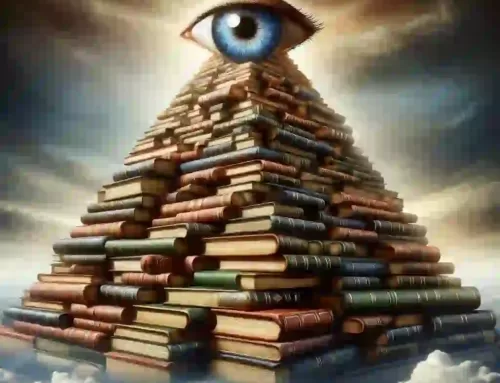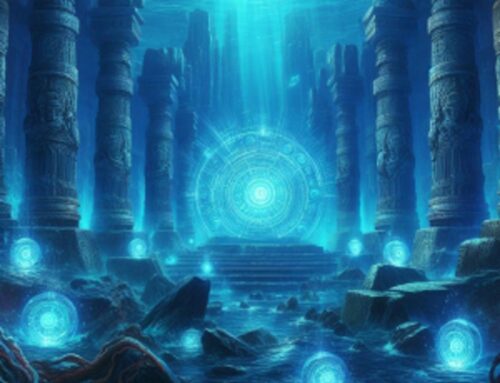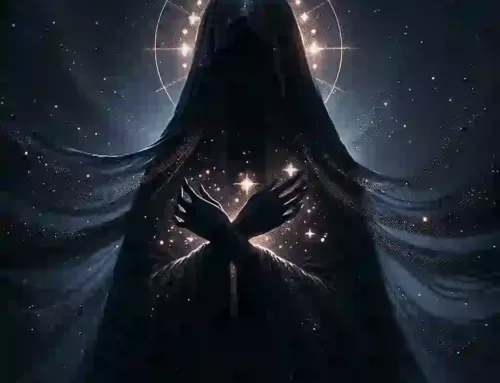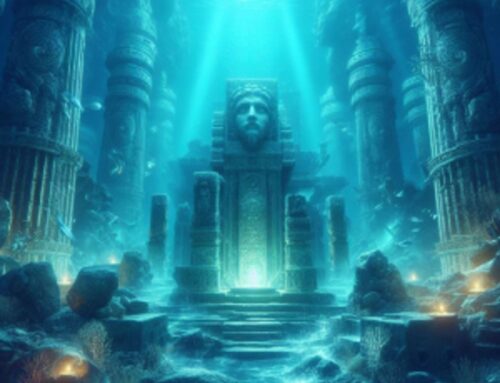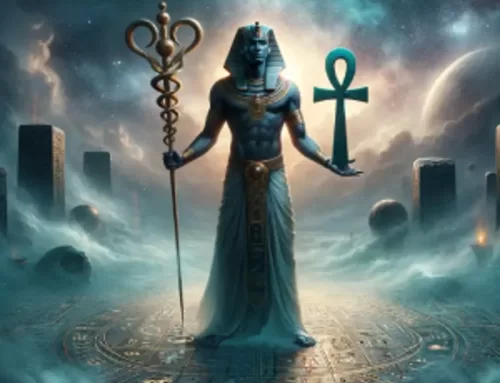Introduction to Kybalion and Kabbalah
In the silent chambers of the ancient world’s most hidden places, where the whispers of the past meet the breath of the future, there lies a wisdom as perennial as the stars themselves. This wisdom, encapsulated in the revered texts of the Kybalion and the sacred scrolls of Kabbalah, offers the discerning seeker a map to navigate the labyrinth of existence. The Kybalion, with its Hermetic axioms, whispers the secrets of the cosmos through principles as immutable as the very laws that govern the heavens. Meanwhile, the Kabbalah, with its mystical Tree of Life, provides a divine architecture of the soul’s ascent towards enlightenment and mysticism.
Mysticism and society have received little attention in literature, but their mutual relationship is crucial to understanding the spiritual universe and its influence on society. (1)

Together, these age-old traditions speak of a world beyond the veil of the ordinary, inviting us into a dance of creation and destruction, of becoming and unbecoming. They urge us to look within and beyond, to see the unity in the duality, and to understand that our reality is but a reflection of greater universal truths. As we embark on this journey through the mystical pathways of Kybalion and Kabbalah, we seek not only knowledge but transformation — a transmutation of the soul that aligns us with the rhythms of the universe and the eternal quest for wisdom.
We shall explore the confluence of these spiritual streams, delving into their shared truths and distinct insights. We shall uncover the universal laws that guide us silently through the vicissitudes of life and the mystical pathways that beckon us towards our higher selves. This exploration is more than an academic pursuit; it is a pilgrimage of the soul, a quest for the ancient wisdom that illuminates the path to our ultimate destiny.
The Universal Laws and The Tree of Life
Navigating the sacred landscapes where the Kybalion and Kabbalah (Hebrew: QBLH) intersect, we are invited to explore a realm where universal laws are mirrored in the intricate structure of the Tree of Life. This central symbol of Kabbalistic wisdom ascends, reaching the heavens, its roots anchored deeply within the earth. Each Sephirah on the Tree of Life embodies divine emanations, facets of the Infinite, revealing the complex nature of existence. In parallel, the Kybalion, through its seven Hermetic Principles, imparts ancient cosmological insights, suggesting that the universe operates not amid chaos, but within a divine order accessible to those who seek with earnestness.
The Principle of Mentalism and Kether
At the pinnacle of the Tree of Life, we find Kether, the emanation epitomizing the purest form of consciousness, mirroring the Kybalion’s Principle of Mentalism. This principle proposes that the All is Mind; the universe itself a mental construct of the All. The parallel is stark: just as Kether is the origin from which all Sephirothic energy emanates, the Kybalion reveals that the cosmos is born from a singular, universal consciousness.
Correspondence Between the Sephiroth and Hermetic Principles
Navigating through the Tree’s pathways, we encounter the Principle of Correspondence, “As above, so below; as below, so above.” This principle shines a light on the interconnectedness of the cosmos, mirrored in the balance between the Sephiroth. Each sphere, from the sublime heights of Binah (Understanding) to the earthly domain of Malkuth (Kingdom), captures a cosmic truth, reflecting the Hermetic teachings that weave through the universe’s structure.
Vibration and the Pathways of the Tree
Venturing further into the Kybalion, we come across the Principle of Vibration, affirming that nothing is static; everything moves; everything vibrates. This resonates with the energy channels linking the Sephiroth, the invisible pathways of divine force animating the Tree of Life.
The final mystical state conveys the essential feature of consciousness—phenomenality—with little, if any, intentional content. (2) Through contemplation and scholarly pursuit, the seeker learns to sense these subtle vibrations, attuning to the celestial symphony that both the Kabbalah and Kybalion articulate.
Mentalism and the Power of Thought in Kybalion and Kabbalah
The illuminated corridors of mysticism, where the Kybalion and Kabbalah’s ancient wisdom coalesce, reveal the primacy of thought in the cosmos’s creation and sustenance. The Principle of Mentalism, as unveiled in the Kybalion, asserts the universe as a mental construct, a thought emanated from the All. Kabbalistic teachings, with their profound exegesis on divine emanations, resonate with this principle, particularly through the conceptual prisms of Chokmah (Wisdom) and Binah (Understanding), which together forge the reality we perceive. (3)
The Fabric of the Cosmos and the Mind
The Kybalion’s declaration that “The All is Mind” posits a universe conceived in the mental womb of the Absolute, where every particle and wave, every star and galaxy, are but thoughts made manifest. This echoes in the Kabbalistic view where the Infinite Light, through Chokmah and Binah, articulates the divine thought into the framework of existence. Here, thought is not merely a human faculty but the divine language of creation itself.
Chokmah and Binah: The Divine Intellect Manifest
In the divine architecture of the Kabbalah, Chokmah and Binah stand as the pillars of Wisdom and Understanding, the initial sparks from which the Tree of Life blooms. Chokmah, with its boundless dynamism, ignites the divine thought, while Binah, the great receptor, molds this thought into the templates of reality. Their interplay reflects the Kybalion’s Mentalism, where thought precedes form, and understanding gives shape to the ethereal.
The Alchemy of Thought
The mystical path beckons not just to understand the power of thought but to wield it with precision and intent. The Kybalion’s teachings on Mentalism are not mere philosophical musings but practical wisdom for the adept to navigate the mental universe. Similarly, Kabbalistic practices, especially meditation on the Sephiroth, aim to refine the practitioner’s mental faculties, aligning them with divine thought patterns. This mental alchemy transforms the base lead of unrefined consciousness into the gold of enlightened awareness.
Practical Applications in the Seeker’s Journey
The adept’s journey is marked by the cultivation of thought, for through thought, one interacts with the fabric of the cosmos. Practical applications of these teachings manifest in meditation, visualization, rituals, and the sacred art of intention-setting. Through these practices, guided by the principles of both Kybalion and Kabbalah, the seeker learns to master the currents of mental energies, steering through life with wisdom and purpose.
The Ethereal Bridge
Beyond the veil of the manifest world lies the ethereal bridge, a pathway of light forged by the power of thought. This bridge connects the finite to the Infinite, the earthly to the divine. Walking this bridge requires understanding and applying the Principle of Mentalism, a task for which both Kybalion and Kabbalah serve as venerable guides. They teach us that in the silence of the mind, we hear the whispers of the cosmos, and in the stillness of thought, we find the footprints of the divine.
Correspondence Between Worlds
The mystical axiom “As above, so below; as below, so above” encapsulates the essence of the Principle of Correspondence, a cornerstone both in the Hermetic philosophy of the Kybalion and the mystical depth of Kabbalah. This principle, transcending mere metaphor, suggests a universe where the macrocosm reflects the microcosm, and the laws governing the stars are mirrored in the workings of the human heart. Through this lens, we glimpse the interconnectedness of all existence, revealing that the vast expanse of the cosmos and the inner landscape of the soul are but two sides of the same divine coin.
The Macrocosm and Microcosm
The Kybalion presents the universe as a complex, interconnected system where each part reflects the whole. This concept is mirrored in Kabbalah through the structure of the Tree of Life, which maps the macrocosm of the divine creation and the microcosm of human experience. Each Sephira on the Tree not only represents an aspect of the divine but also corresponds to aspects of the human condition, illustrating a profound unity between the cosmos and the individual.
The Ladder of Lights: Bridging the Divine and the Human
The mystic journey, as outlined in both traditions, is often depicted as ascending a ladder or tree, moving through various states of being towards unity with the divine. This ascent requires understanding the correspondences between the different levels of reality. It is a path of transformation, where the seeker learns to see the divine in the mundane and the mundane in the divine, recognizing the sacredness of all life.
A Pathway to Wisdom
One practical application of the Principle of Correspondence is meditation on the Sephiroth of the Kabbalistic Tree of Life. Each Sephirah acts as a gateway to understanding different aspects of the self and the universe, offering insights that guide the seeker toward spiritual enlightenment. These meditative practices, reflective of the Hermetic maxim, enable a direct experience of the correspondences between the various dimensions of existence.
The Interplay of Forces
In both Kybalion and Kabbalah, the interaction between opposing forces—such as mercy and severity, or expansion and contraction—is essential for the manifestation of the cosmos. Understanding these dynamic correspondences allows the adept to navigate life’s challenges with balance and harmony, recognizing that every action reverberates through the layers of reality.
Wisdom in the Web of Life
The Principle of Correspondence teaches that wisdom lies in recognizing the interconnected web of life, where every thought, word, and deed has implications beyond our immediate perception. By internalizing this principle, the adept learns to act with mindfulness and compassion, aware of the ripples their actions create in the vast ocean of existence.
Vibration and Divine Emanations
In the echoing halls of ancient wisdom, where the Kybalion and Kabbalah whisper timeless secrets, the Principle of Vibration emerges as a fundamental truth, casting illumination on the nature of divine emanations. This principle, asserting that everything in the universe is in constant motion, resonates with the vibrational essence of the Sephiroth (Sephirot, Sefirot)) on the Kabbalistic Tree of Life, each emanating its unique frequency in the symphony of creation.
The Eternal Dance of Creation
The Kybalion teaches us that nothing rests; everything moves; everything vibrates. This cosmic dance of vibration is mirrored in the Kabbalah, where the Sephiroth vibrate with divine light, channeling the creative force throughout the Tree of Life. This vibrational harmony creates the fabric of the universe, weaving together the physical and spiritual realms in a dynamic interplay of energy.
Tuning into the Frequencies of the Sephiroth
Each Sephirah (Sephira, Sefira) on the Tree of Life not only represents a divine attribute but also vibrates at a specific frequency, influencing various aspects of the human experience and the universe at large. By attuning to these frequencies through meditation and contemplation, the seeker can align themselves with the divine flow of energy, facilitating personal transformation and spiritual awakening.
The Vibrational Nature of Reality
Understanding the Principle of Vibration allows the adept to perceive the world not as static and inert but as a living, breathing entity, vibrating with life. This perception shifts the approach to spiritual practice, emphasizing the importance of raising one’s vibrational frequency to resonate with higher states of consciousness and divine will.
Harmony and Dissonance
Just as musical notes can harmonize or create dissonance, the vibrations within the universe can be in alignment or at odds with one another. The study of the Kybalion and Kabbalah teaches the adept to navigate these vibrations, seeking harmony within themselves and the world around them, and to use their understanding of vibration to heal and uplift.
The Alchemy of Vibration
Beyond mere philosophy, the Principle of Vibration offers practical alchemical tools for the mystic. Through practices such as chanting, prayer, and the use of sacred sounds, the adept can consciously alter vibrations, transforming lower energies into higher, more refined states. This spiritual alchemy, rooted in the understanding of vibration, is a key to unlocking the mysteries of the Kybalion and Kabbalah, offering a pathway to enlightenment and unity with the divine.
The Path of Return Through Initiation and Ascension
At the heart of the mystical traditions encapsulated by the Kybalion and Kabbalah lies the Path of Return, a journey of the soul’s initiation and ascension back to its divine source. This path, winding through the realms of wisdom and understanding, beckons the seeker to traverse the spiritual landscape, guided by the light of ancient teachings.
Initiation into the Mysteries
The journey begins with initiation, an entry point into the sacred mysteries that lie beyond the veil of ordinary perception. In the tradition of the Kybalion, this initiation invites the seeker to embrace the Hermetic principles, setting the stage for a transformation that transcends the physical realm. Similarly, Kabbalistic initiation unfolds through the engagement with the Tree of Life, each Sephirah acting as a gatekeeper to deeper layers of spiritual insight.
Ascending the Tree of Life
The Kabbalistic Tree of Life (Otz Chaim) serves as a map for the soul’s ascension, a structured path through which the initiate navigates the complexities of existence. This ascent through the Sephirot is mirrored in the Hermetic journey, where each principle of the Kybalion provides a stepping stone towards higher understanding and closer union with the All.
Alchemy of the Soul
Central to both the Kybalion and Kabbalah is the concept of alchemy, not of metals, but of the soul itself. This spiritual alchemy involves the transmutation of base desires into noble virtues, the refinement of consciousness, and the alignment of the will with the divine. Through practices such as meditation, contemplation, and the embodiment of divine attributes, the seeker undergoes a profound transformation, becoming a vessel for the divine light.
The Mystical Marriage
The culmination of the Path of Return is the Mystical Marriage, the union of the soul with the divine. This sacred union represents the ultimate goal of the mystical journey, a state of consciousness where the seeker and the sought become one. In the language of the Kabbalah, it is the union of Tiferet (Beauty) with Kether (Crown), the realization of the soul’s divine origin and purpose. In Hermetic terms, it is the realization that the microcosm and macrocosm are reflections of each other, bound by the same divine laws.
While the Path of Return is marked by personal effort and inner transformation, the seeker is not alone. The teachings of the Kybalion and Kabbalah serve as guides, offering wisdom and illumination. Moreover, the community of fellow seekers and the lineage of spiritual teachers provide support and companionship, ensuring that the journey, though arduous, is also one of connection and shared purpose.
Alchemy and Transformation
In the mystical quest for transformation and the healing of the world, both alchemy and the principles of Kabbalah play pivotal roles. These ancient practices offer a profound path for personal and global healing, emphasizing the spiritual alchemy of transformation and the concept of Tikkun Olam (Hebrew: ThYQVN OVLM), or the repair of the world.
The Alchemical Journey
Alchemy is traditionally symbolized as the divine art of transformation, seeking not just the transmutation of base metals into gold but aiming for the loftier goal of spiritual enlightenment and the purification of the self. This path is intricately connected with the Hermetic principles, as outlined in the Kybalion, and finds deep resonance in the teachings of Kabbalah, where the transformation and elevation of the soul are central themes. The alchemical process is a metaphor for the inner transformation that leads to spiritual ascension, ultimately enabling the higher soul to ascend to a more enlightened state.
Transformation Through the Sephirot
The Tree of Life in Kabbalah serves as a map for this transformative journey, where each Sephirah (sphere) on the tree represents a step towards spiritual enlightenment and unity with the divine. The process of climbing the Tree of Life, from Malkuth (the Kingdom) to Kether (the Crown), symbolizes the soul’s ascent through various stages of initiation and spiritual awakening. This journey through the Sephirot is akin to the alchemical process of turning lead into gold, symbolizing the transformation of the lower, base aspects of the self into the higher, spiritual aspects that resonate with the divine.
Tikkun Olam: Healing the World
Central to the Kabbalistic worldview is the concept of Tikkun Olam, which calls for the healing of the world through acts of kindness, justice, and spiritual practice. This principle suggests that humanity holds a unique responsibility within the creation to repair and elevate the world, aligning it more closely with the divine blueprint. The teachings of the Kybalion, with its emphasis on universal laws and principles, support this vision by highlighting the interconnectedness of all things and the impact of individual actions on the cosmic whole.
Practical Applications in the Seeker’s Journey
The practical applications of these teachings are vast, encompassing meditation, contemplation, and the practice of divine virtues. Through these practices, individuals are guided towards an alignment with their higher selves and the divine will, contributing to the healing of the world on both a micro and macro scale. The journey of Tikkun Olam is not just a path of personal enlightenment but a mission to bring about a more harmonious and spiritually aligned world.
Conclusion
In the interplay of light and shadow, where the ancient wisdom of the Kybalion and Kabbalah unfolds, we, the seekers of truth, find ourselves at a crossroads of transformation and transcendence. Through the veils of the material and into the essence of the spiritual, our journey has revealed the timeless principles that govern the cosmos and the soul’s path through the myriad dimensions of existence.
We have traversed the landscapes of mentalism, delved into the vibrational essence of the universe, ascended the symbolic Tree of Life, and undertaken the alchemical transformation required for Tikkun Olam—the healing of the world. Each step, illuminated by the guiding lights of the Kybalion and Kabbalah, has brought us closer to understanding the interconnectedness of all that is, seen and unseen, and the divine spark that resides within each of us.
As we stand at this juncture, the call to action becomes clear: to embody the teachings of the Kybalion and Kabbalah in our daily lives, weaving the principles of Hermeticism and the wisdom of the Tree of Life into the fabric of our existence. This is not a journey of the solitary mystic but a collective endeavor of souls united in the quest for enlightenment and the betterment of the world.
Seek the hermetic kabbalistic Light
Let this conclusion not be an end but a new beginning, a call to further engagement with the Hermetic Academy, an authentic hermetic kabbalistic mystery school. Here, in the company of fellow aspirants and guided by the torchbearers of the timeless traditions, you will find support, knowledge, and inspiration to deepen your understanding and practice of these profound teachings.
FAQ – Kybalion and Kabbalah
1. What is the main similarity between the Kybalion and Kabbalah?
Both the Kybalion and Kabbalah emphasize the interconnectedness of the universe through their teachings. The Kybalion introduces Hermetic principles like Mentalism, Correspondence, and Vibration, while Kabbalah explores these concepts through the Tree of Life and its Sephirot, illustrating how divine energies permeate all levels of existence.
2. How does the Principle of Mentalism from the Kybalion relate to Kabbalistic teachings?
The Principle of Mentalism, stating that “The All is Mind,” mirrors Kabbalistic views on the power of thought and intention in creation. Kabbalah teaches that the universe was conceived through divine thought, paralleling the Kybalion’s idea that all reality is a mental construct of the All.
3. Can the Kybalion and Kabbalah’s teachings impact personal transformation?
Yes, both traditions offer profound insights into personal transformation. The Kybalion’s principles guide individuals to understand the laws of the universe, facilitating a change in perception and reality. Kabbalah’s structured approach through the Tree of Life provides a pathway for spiritual ascent and moral improvement.
Tikkun Olam is a Kabbalistic concept referring to the healing or repair of the world. It aligns with the teachings of the Kybalion and Kabbalah by emphasizing the individual’s role in creating harmony within the universe. Through personal development and adherence to universal laws, individuals contribute to the cosmic balance, embodying the principle of Tikkun Olam.
5. How can beginners start studying the Kybalion and Kabbalah?
For those at the threshold of their spiritual journey, eager to delve into the Kybalion and Kabbalah, the path may initially appear daunting due to the depth and complexity of these teachings. However, the Hermetic Academy emerges as a beacon of guidance and clarity in this explorative quest. Unlike self-guided studies, which lead to confusion or misinterpretation, the Academy presents a structured pathway illuminated by seasoned adetps and a curriculum that’s both accessible and profound.
Reference:
(1) Scholem, G. (1967). Mysticism and Society. Diogenes, 15, 1 – 24. https://doi.org/10.1177/039219216701505801.
(2) Lancaster, B. (2015). Hermeneutic Neurophenomenology in the Science-Religion Dialogue: Analysis of States of Consciousness in the Zohar. Religion, 6, 146-171. https://doi.org/10.3390/REL6010146.
(3) Rubenstein, E. (2024) The Hermetic Experience: From Mystery to Self-Knowledge. Hermetic World, Paphos.

